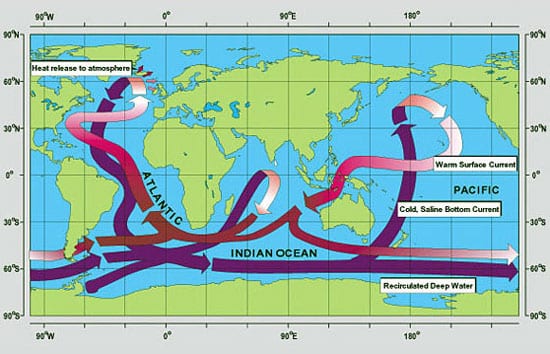Deep Ocean Circulation
In today's North Atlantic, warm and salty surface and near-surface currents flow northward from the tropics to the high latitudes. These waters release heat to the atmosphere and warm the region, at the same time becoming colder. As they become colder, they become denser and less bouyant. Some of this surface water sinks to depth in the Nordic, Irminger, and Labrador Seas and flows southward as North Atlantic Deep Water (NADW). NADW fills the deep North Atlantic Ocean basin and can be traced as a salinity maximum in deep currents that circulate around Antarctica, which eventually spread into the deep Indian and Pacific Oceans. The greater the sinking of surface waters to form NADW at high northern latitudes, the greater the flux of low-latitude waters to replace sinking waters.

A schematic diagram of the global ocean circulation pathways, sometimes referred to as the "Ocean Conveyor." (W. Broecker, modified by E. Maier-Reimer)
Many different proxy records have yielded a consistent picture of Atlantic circulation for the last glaciation and abrupt deglacial events. During the last glacial maximum, NADW did not extend as deep as it does today, and the Southern Ocean Water (SOW) filled the deep Atlantic. The rate of overturning was also weaker than it is today. SOW also replaced NADW in the deep Atlantic during the Younger Dryas, a North Atlantic millennial cold event that punctuated the deglacial warming trend. NADW was restricted to the very shallow North Atlantic during a deglacial event of massive iceberg discharge known as Heinrich event 1, consistent with evidence that the export of deepwater nearly ceased. The reduced northward heat transport associated with the Younger Dryas and Heinrich Event 1 slowdowns in ocean circulation contributed to North Atlantic cooling and caused high latitude southern hemisphere warming. These high latitude temperature anomalies influenced global climate, including the low latitude hydrological cycle.
Much less is known about the details of ocean circulation in Earth's distant past. From carbon, oxygen and neodymium isotope ratios of deep-dwelling organisms, we get glimpses of past patterns and changes in those patterns. In contrast to today's ocean, for example, geochemical tracers tell us that earth's densest water probably formed in the Pacific basin in the early Paleogene. Ocean model experiments suggest that deep water formation may have shifted abruptly at the Paleocene-Eocene boundary (55 Ma ) from the southern Pacific to the northern Pacific in response to gradual global warming and the accompanying precipitation changes. Recent data supports this model prediction.
Ocean circulation changes on all these time scales redistribute heat and nutrients, and may have profound effects on surface temperatures, the global hydrologic cycle, and atmospheric carbon dioxide. Our work is motivated by the need to understand the ocean's role in climate change, including possible analogs for future change.
We use many methods to reconstruct past changes in ocean circulation on tectonic, orbital, and shorter times scales. These techniques include geochemical and sedimentological evidence of changes in past circulation, as well as forward and inverse numerical modeling to test for consistency with paleoceanographic evidence and interpretation.
Researchers
Related Links
- Deep Ocean Circulation and Climate
Oceanus magazine article by Jerry McManus and Delia Oppo explaining how sediments can provide important clues about past ocean circulation. - The Coral-Climate Connection
from Oceanus magazine - Ocean Circulation and Radiocarbon
Oceanus magazine article by Lloyd Keigwin describing how radiocarbon in deep-sea sediments reveals shifts in ocean circulation and climate